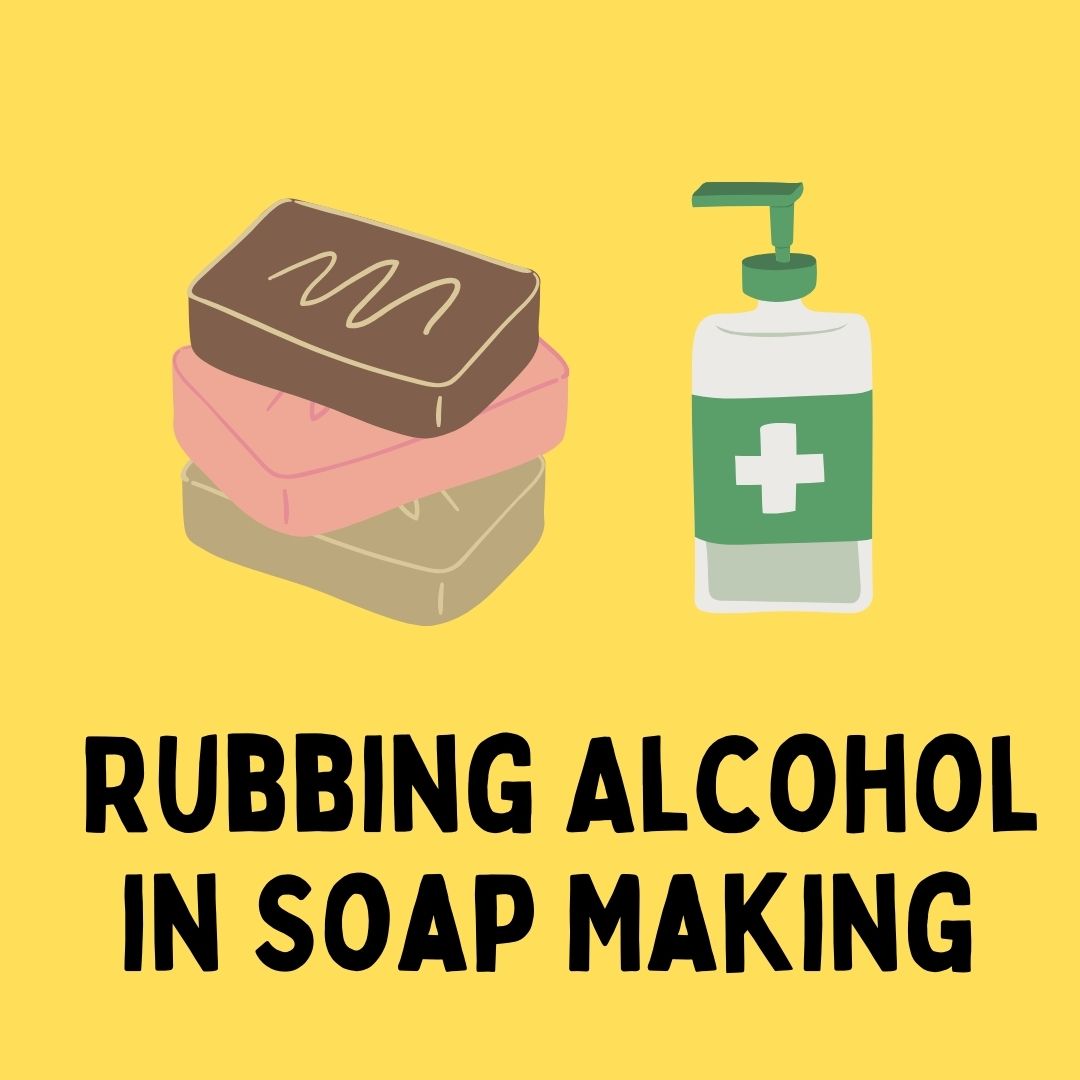
Soap making is a craft that combines science and creativity to produce cleansing products. Many soap makers incorporate rubbing alcohol into their recipes for various purposes. In this extensive article, we will explore the role of rubbing alcohol in soap making, its benefits, potential challenges, and the step-by-step process of incorporating it into your soap formulations.
Rubbing alcohol, also known as isopropyl alcohol (IPA), is a versatile solvent with various applications. In soap making, it serves multiple functions, from enhancing clarity and texture to aiding in the prevention of certain issues like soda ash. Understanding how to incorporate rubbing alcohol properly can elevate the quality of your handmade soaps.
Benefits of Using Rubbing Alcohol in Soap Making:
- Preventing Soda Ash:
- One common benefit of rubbing alcohol in soap making is its ability to prevent or reduce soda ash formation on the soap’s surface. Soda ash is a white, powdery substance that can develop during the soap curing process, affecting the soap’s appearance.
- Improving Clarity:
- Rubbing alcohol can contribute to clearer soap. It helps eliminate bubbles on the soap’s surface and promotes a smoother finish, resulting in a more visually appealing product.
- Enhancing Texture:
- Adding rubbing alcohol to your soap formulation can enhance the texture of the soap. It aids in achieving a smoother and more professional-looking surface.
- Sanitizing Equipment:
- Rubbing alcohol is an excellent tool for sanitizing your soap-making equipment. Ensuring cleanliness is crucial in soap making to prevent contamination and produce high-quality products.
- Cleaning: You can use rubbing alcohol to clean and disinfect surfaces and tools before starting soap making.
- Mold release: In melt-and-pour soap making, a light mist of rubbing alcohol can be sprayed on the mold to prevent the soap from sticking. However, ensure it evaporates completely before pouring the soap.
- Layering: Rubbing alcohol can be used to create thin layers between different colored or scented soap layers in melt-and-pour soap. This helps the layers bond together, preventing color bleeding or separation. However, note that using too much can cause the layers to become cloudy or uneven.
- Hardening: A small amount of rubbing alcohol (around 1 teaspoon per pound of soap) can be added to cold process soap recipes to speed up the hardening process. However, excessive amounts can interfere with the saponification process and leave the soap with a tacky or greasy feel.
Types of Rubbing Alcohol for Soap Making:
- 70% Isopropyl Alcohol:
- This is a commonly used concentration for soap making. The lower alcohol content allows for a slower evaporation rate, giving you more time to work with the soap.
- 91% or 99% Isopropyl Alcohol:
- These higher concentrations can be used, but they evaporate more quickly. They are often preferred for quick-drying applications or when you want to speed up the soap-making process.
How to Use Rubbing Alcohol in Soap Making:
Follow these steps to incorporate rubbing alcohol into your soap-making process:
- Prepare Your Soap Mixture:
- Begin by creating your soap mixture according to your chosen recipe. Follow the instructions for mixing oils, lye, and water.
- Mold Your Soap:
- Pour the soap mixture into your chosen mold. Smooth the top with a spatula or spoon.
- Prepare the Rubbing Alcohol Solution:
- In a spray bottle, mix rubbing alcohol with water. The ratio can vary, but a common mixture is equal parts alcohol and water.
- Spray the Surface:
- Once your soap is in the mold, spray the surface with the rubbing alcohol solution. This helps eliminate bubbles and promotes a smoother finish.
- Prevent Soda Ash:
- After pouring the soap into the mold and before it hardens completely, you can spray the surface again with rubbing alcohol to help prevent soda ash formation.
- Allow to Cure:
- Let your soap cure according to your recipe’s guidelines. The rubbing alcohol helps improve the overall appearance during the curing process.
Tips and Considerations:
- Experiment with Ratios:
- Depending on your specific soap recipe and desired outcome, you may need to experiment with the ratio of rubbing alcohol to water. Finding the right balance is key to achieving optimal results.
- Avoid Overuse:
- While rubbing alcohol can offer numerous benefits, excessive use may lead to drying out the soap or affecting its performance. Start with small amounts and adjust accordingly.
- Choose Quality Ingredients:
- The quality of your soap ingredients matters. High-quality oils, lye, and fragrance oils contribute to the overall success of your soap-making project.
- Work in a Well-Ventilated Area:
- Rubbing alcohol fumes can be strong. Ensure you are working in a well-ventilated space, or use a protective mask if needed.
Challenges and Common Questions:
- Does Rubbing Alcohol Affect Soap Scent?
- Rubbing alcohol, when used in moderate amounts, is not known to affect the scent of soap significantly. However, if you use excessive amounts, it may contribute to a stronger alcohol smell.
- Can I Use Other Alcohol?
- While isopropyl alcohol is commonly used, some soap makers experiment with other alcohols, such as ethanol. However, it’s essential to consider the specific properties of the chosen alcohol and its potential impact on the soap.
- What if I Don’t Have Rubbing Alcohol?
- If rubbing alcohol is not available, you can use alternatives like witch hazel or a vodka-water mixture. These alternatives may not have the exact properties of rubbing alcohol, so some experimentation may be needed.
- How Does Rubbing Alcohol Prevent Soda Ash?
- Rubbing alcohol helps prevent soda ash by reducing the surface tension of the soap, which can inhibit the formation of the white powdery substance. It also helps the soap harden more evenly.
Important considerations:
- Do not use rubbing alcohol as a primary ingredient in soap making. It has no saponification properties and won’t contribute to the formation of soap.
- Use only high-quality, food-grade rubbing alcohol. Some varieties might contain additives unsuitable for soap making.
- Apply rubbing alcohol sparingly and carefully. Too much can negatively affect the final product’s texture, appearance, and performance.
- Always be cautious when using flammable liquids like rubbing alcohol near heat sources. Ensure proper ventilation and follow safety precautions.
Alternatives to rubbing alcohol for Soap Making:
- For cleaning: Dish soap diluted in water is an effective and readily available alternative.
- For mold release: You can use specialized mold release sprays designed for soap making.
- For layering: Some soap makers use glycerin or vegetable oil instead of rubbing alcohol for layering. Experiment with different methods to find what works best for you.
- For hardening: There are other additives commonly used to accelerate the hardening process in cold process soap, such as sodium lactate or epsom salts. Consult reliable soap making resources for suitable alternatives.
Conclusion:
Incorporating rubbing alcohol into your soap making process can offer several benefits, from preventing soda ash to improving clarity and texture. Understanding the types of rubbing alcohol, how to use it effectively, and considering potential challenges will help you enhance the quality of your handmade soaps. As with any soap making ingredient, experimentation and careful consideration of your specific soap recipe are key to achieving the desired results. Whether you’re a seasoned soap maker or a beginner, the versatile nature of rubbing alcohol can be a valuable addition to your soap making toolkit.
Related FAQs on Rubbing Alcohol for Handmade Soaps:
- Rubbing Alcohol for Handmade Soaps: Is It Necessary?
- Rubbing alcohol is commonly used in handmade soaps for various purposes, including preventing soda ash, improving clarity, and aiding in the removal of bubbles. While it’s not mandatory, many soap makers find it beneficial for achieving a smoother and more visually appealing product.
- What Rubbing Alcohol Is Best for Soap?
- The most commonly used rubbing alcohol for soap making is isopropyl alcohol (IPA). A concentration of 70% is often preferred for soap making due to its slower evaporation rate, providing more time to work with the soap. However, higher concentrations like 91% or 99% can also be used.
- What Alcohol Spray Is Used for Soap Making?
- The alcohol spray used for soap making is typically a mixture of rubbing alcohol (isopropyl alcohol) and water. Common ratios include equal parts alcohol and water, though experimentation with ratios may be necessary based on specific soap recipes and desired outcomes.
- Do I Need Alcohol for Melt and Pour Soap?
- While rubbing alcohol is not strictly necessary for melt and pour soap, it can still be beneficial. Spraying the surface of melt and pour soap with alcohol helps eliminate bubbles and ensures a smoother finish. It can also aid in the adhesion of layers in multi-layered designs.
- Can I Use Ethanol in Soap Making?
- Yes, ethanol can be used in soap making. It shares some properties with isopropyl alcohol and can serve similar purposes in soap formulations. However, considerations such as the ethanol concentration and its potential impact on the soap should be taken into account.
- Can You Buy Rubbing Alcohol?
- Yes, rubbing alcohol (isopropyl alcohol) is widely available for purchase at pharmacies, grocery stores, and online retailers. It comes in various concentrations, so be sure to choose the one that aligns with your soap making needs.
- Why Is Alcohol Used in Saponification?
- Alcohol is not typically used in the saponification process itself. However, it is commonly used after the soap has been poured into molds to prevent soda ash, improve the soap’s appearance, and aid in the curing process.
- What Is Soda Ash on Soap?
- Soda ash is a white, powdery substance that can form on the surface of soap during the curing process. It is primarily composed of sodium carbonate and occurs when lye reacts with carbon dioxide in the air. Rubbing alcohol is often used to prevent or reduce soda ash.
- What Alkali Can Be Added to Make Soft Soap?
- Potassium hydroxide (KOH) is the alkali commonly used to make soft soap, also known as potassium soap. It is used in contrast to sodium hydroxide (NaOH), which is used for making hard soap or sodium soap.
- Alternatives to Rubbing Alcohol for Soap Making
- Alternatives to rubbing alcohol for soap making include witch hazel, vodka-water mixtures, or other alcohol-based solutions. These alternatives can be used to achieve similar effects in terms of preventing soda ash and improving soap appearance.
- How to Get Rid of Bubbles on Soap Without Alcohol
- If you prefer to avoid alcohol, alternatives for getting rid of bubbles on soap include tapping the mold to release air bubbles, using a toothpick to pop bubbles, and pouring the soap at a lower temperature. Experimenting with different pouring techniques can help achieve a bubble-free finish.

My name is Logan, and I’m a 36-year-old dad who owns a small pressure-washing company in the suburbs of Atlanta, Georgia. My main goal with rubbing-alcohol.com is to show you how versatile isopropyl rubbing alcohol can be! I hope. You find it useful.
